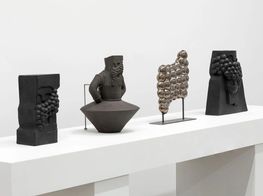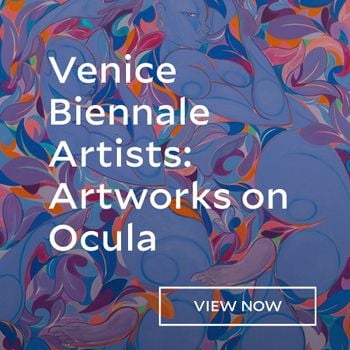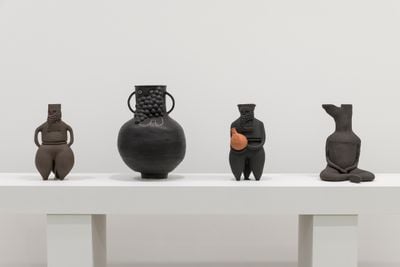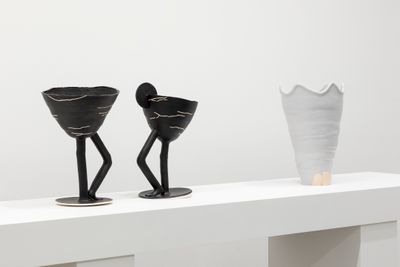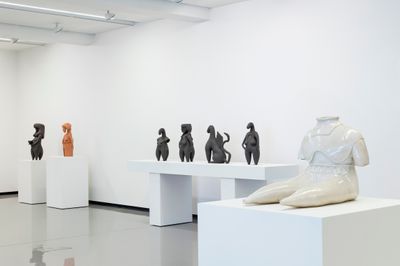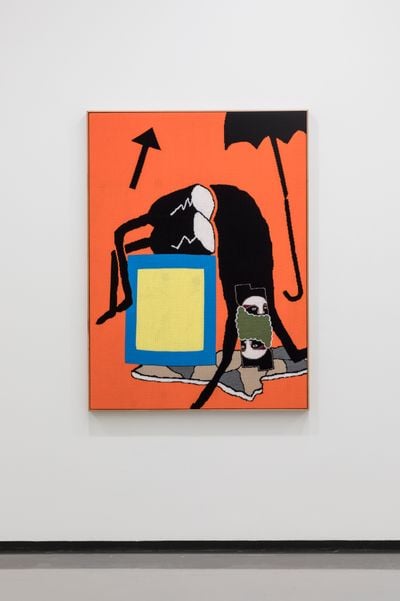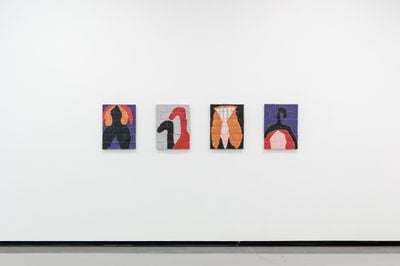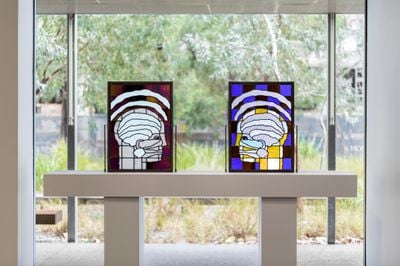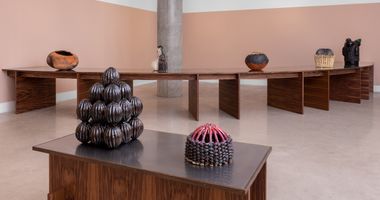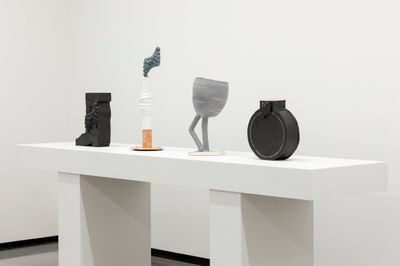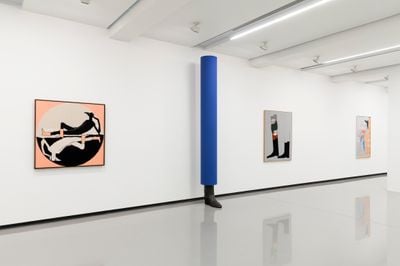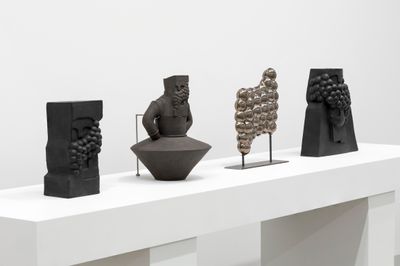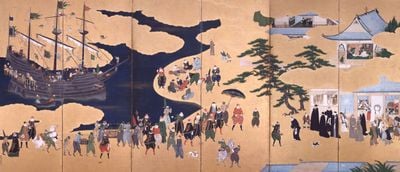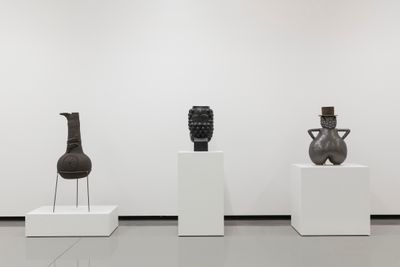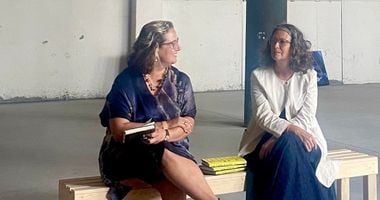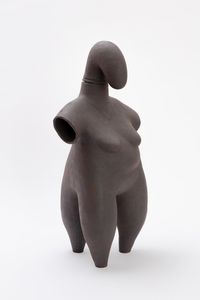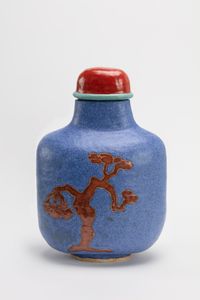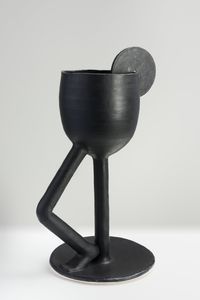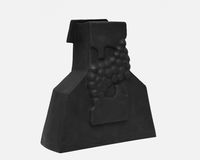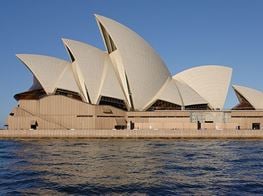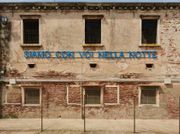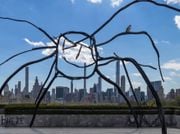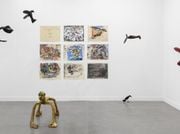Renee So: Elginisms and a New World
Left to right: Renee So, Woman I (2017); Woman II (2017); Woman VI (2020); Woman XIII (2022). Exhibition view: Provenance, Monash University Museum of Art, Melbourne (27 April–8 July 2023). Photo: Andrew Curtis.

Left to right: Renee So, Woman I (2017); Woman II (2017); Woman VI (2020); Woman XIII (2022). Exhibition view: Provenance, Monash University Museum of Art, Melbourne (27 April–8 July 2023). Photo: Andrew Curtis.
Renee So is fascinated by history—particularly looted artefacts, symbols of civilisations and fallen empires, and objects that fuse different places and times.
Provenance (27 April–8 July 2023) curated by Charlotte Day at Monash University Museum of Art (MUMA), Melbourne, was the first major institutional exhibition in Australia of London-based artist Renee So. It marked a homecoming of sorts for the Hong Kong-born artist, who grew up in Melbourne after immigrating with her mother in 1975 at ten months old.
The exhibition, which is co-produced by MUMA with the University of New South Wales Galleries, is touring to Sydney where it will open at UNSW Galleries from 18 August to 19 November 2023. Featuring 67 works, Provenance surveys more than a decade of practice from 2007 to 2023 and includes paintings, stoneware, ceramics, glass, and textiles.
So has long been interested in how objects can hold multiple stories, not least their sometimes murky histories as the spoils of victory or wars. Her show at Cample Line in Scotland last year, Effigies and Elginisms (2 April–19 June 2022), referenced one of the most famous historic examples of grand larceny: the Elgin Marbles.
From 1801 to 1812, agents of Thomas Bruce, the 7th Earl of Elgin, removed vast amounts of sculpture from the Parthenon in Athens. Outcry was not far behind: in 1812, the English Romantic poet Lord Byron was crusading in verse for their return.
Elgin's story does not end there. Thomas Bruce's son James Bruce (who became the 8th Lord Elgin) was British High Commissioner in China, and in 1860 as part of the Second Opium War gave the order to destroy the Old Summer Palace (Yuanmingyuan), the Qing dynasty palace complex in present-day Beijing.
Widespread destruction and looting of objects in the palace by British and French troops followed, many of which found their way into public collections. UNESCO has estimated that stolen objects from the Old Summer Palace are now located across 47 museums worldwide.
The campaign to return the Elgin Marbles and objects from the Old Summer Palace to their rightful home has never let up, becoming emblematic of concerns around provenance and rightful ownership of objects in museums around the world.
In Provenance, So continues to memorialise these historic moments of larceny by reimagining artefacts that were once found in the Old Summer Palace, as well as various objects that represent historic cultural relations and frictions.
The first works encountered in Provenance at MUMA were a series of oversized snuff and perfume bottles in glazed earthenware. Referencing modern perfumes such as Opium (launched by Yves Saint Laurent in 1977), Snuff (Schiaparelli, 1939), and Colony (Jean Patou, 1938), these heady labels evoke the western romantic exoticism of the East.
These clay replicas were shown alongside other hand-coiled clay reconstructions such as Scholar's Rock (2022) and A Foot Bath for Bound Feet (2022). In shifting size, scale, and materiality, So draws the viewer's attention to the stories and origins of each object.
There is also a humorous aspect to Provenance: the glazed earthenware Cigarette (2015) depicts an upright cigarette with a smoke plume wafting from the top. In Vintage Wine Lover, Martini, and Cosmopolitan (all 2015), a series of clay 'glasses' playfully take on the persona of their respective drinks. Elephant Foot (2015) references colonial safari trophies turned into macabre furniture forms, such as umbrella stands.
So's practice is distinguished by its embrace of craft methods and cross-cultural thinking, a subversive wry gaze, and a persistent feminist worldview. Her distinct 'Woman' sculpture series (2017–ongoing) have drawn from early fertility idols and Venus figures celebrating the female form.
In this interview, the artist speaks with recently appointed MUMA director Dr Rebecca Coates on the historic sources that shape her practice, acknowledging the significance of museums as repositories of material culture and knowledge while recognising the complex origins of their collections.
RCIn museology, the term 'provenance' refers to the history of an artwork or object before it enters a collection. It has added significance now, with increasing attention paid to the origins of objects in collections around the globe, and the desire to redress historic wrongs. Why is the show titled Provenance?
RSProvenance is defined as the origin or beginning of existence of something; or a record of ownership of a work of art or antique. The show's title pays attention to these origin stories and seemed appropriate for my work, which speaks to the complexity of objects and our ability to admire ancient artefacts from distant places in museums, only to realise a lot of it was looted or acquired under questionable circumstances.
It also attends to my own experiences and the questions I often receive about my place of birth, ancestry, nationality, citizenship, my accent, where I grew up, where I live, the difference between being mainland Chinese and Hong Kong-Chinese, and whether I speak Mandarin or Cantonese.
It also speaks to the fact that we all come from our mother's body. Early fertility idols and Venus figures venerated these female forms, celebrating the breasts, womb, and vagina. But the clitoris was ignored by the medical world until the late 1990s, when the Melbourne urologist Helen O'Connell studied the organ and mapped out its complete shape. I've introduced the form of the clitoris in my 'Woman' sculptures.
RCHow have the intervening years, between moving to London and returning to Australia for Provenance, informed how you approached this exhibition in the place that was so significant in your formative years?
RSMy last solo exhibition in Melbourne was in 2010 at Uplands Gallery, a space that built its reputation for nurturing emerging talent, so I knew that most of the work in this show would be new for Australian audiences.
The exhibition reflects my growth as a person as much as of technique. The most recent works in the first gallery, for example Scholar's Rock (2022) or A Foot Bath for Bound Feet (2022), return to themes I explored in art school in Melbourne, such as identity.
I divided the show into different themes for each room within MUMA, which roughly corresponded with different stages of my life since moving to London. These included encountering artefacts in museums for the first time, discovering clay, having a child and marvelling at the female body, and developing a deeper understanding of the 2019–2020 protests in Hong Kong and the lasting legacies of the British Empire.
RCCan you talk about the 'Snuff Bottle' suite of works?
RSThe idea of 'art loot' stolen from the East and traded in the West is something that interests me, particularly artefacts that end up in museum collections. These works speak of trade histories, status and our desire for collecting, and the power of objects through ownership and objectification. Implicit, of course, is the exoticisation of the East.
All depicted objects in that first room, except for Mom Jeans (2022), are of Chinese origin and have been looted, traded, collected, appropriated, fetishised, or commercialised. I often use historic references and introduce changes to these forms, in a desire to revitalise aspects of an ancient culture and encourage new understandings in our contemporary times.
I imagined the objects taken from the Old Summer Palace by British and French soldiers before it was burned down and remade them—like the dog, snuff bottles, scholars' rocks, foot baths for bound feet, and the emperor's bronze vessel.
Snuff bottles were prized for their cultural and collectable status. They were designed by the Chinese imperial workshops after snuff was introduced to Asia by European missionaries in the 17th century. Europeans had stored snuff in snuff boxes, which frequently dried out, but bottles kept snuff moist due to the tiny opening. Their form was used for perfumes such as Snuff and Colony, both first released in the late 1930s, a period of immense social and political change between the First and Second World Wars.
These works speak of trade histories, status and our desire for collecting, and the power of objects through ownership and objectification.
In the 1970s and 80s, there was a return to exoticism and a nostalgic view of the "East" when luxury brands such as Yves Saint Laurent and Dior appropriated traditional snuff bottle forms to sell perfumes such as Opium and Poison.
RCProvenance showcases works you have made in ceramics, textiles, and most recently in glass. What drew you to working with knitted materials, and later clay?
RSMediaeval tapestries I have seen in art history books were often woollen reproductions of Old Master oil paintings. I was also researching chinoiserie and the European craze for Chinese porcelain, and reflecting on how the once highly prized art form of Chinese ceramics is now considered to be craft or "decorative" art in the West.
RCI'm interested in some of your more recent wall works, made up of a series of tiles. They reminded me of the large ceramic friezes commissioned for modernist building facades and public spaces in countries such as Brazil. Did those traditions inform your thinking in any way?
RSI was inspired by tiles in architecture and public spaces across time. The biggest influence was the reconstructed Ishtar Gate of Babylon which I saw at the Pergamonmuseum around 2007. When I was researching the Bauhaus for my solo exhibition, Ancient and Modern at De La Warr Pavilion in 2019, I discovered an amazing tiled room by Kandinsky at the Strasbourg Museum of Modern and Contemporary Art.
Humans have been making things from clay for 30,000 years and seeing these earlier examples makes me feel like I'm part of something bigger than the present.
I also started noticing the tiles I encountered in my daily life—in London tube stations, old building facades, and public murals in local parks and schools. I like the range and ubiquity of tiles; they inhabit both indoor and outdoor worlds.
RCYou describe yourself as a self-taught ceramicist. How do you think this informs the way you work with the material? Does this give you a certain freedom from tradition?
RSI've figured out how to work within my limitations and still get what I want from clay. It's pretty basic—hand-building with coils and slabs, decorating with store-bought glazes, or not glazing at all. I appreciate what else can be done with clay—throwing, for example—but I don't feel the need to do it anymore, which is liberating.
RCThere's a humorous aspect to Provenance—I'm thinking particularly of your works from 2015, which seem very different in inspiration and intent to others you have developed over the last decade: Cigarette, Vintage Wine Lover, Martini, Cosmopolitan, Elephant Foot. What was the impetus for these works?
RSThe cigarette, beard, and wine glass are motifs I've singled out from the knitted paintings of Bellarmine, the bearded man character I've portrayed a lot. They were inspired by English drinking culture—Bellarmine jugs were vessels for beer and wine—and the pubs and gentlemen's clubs where men went to drink, smoke, and relax. Elephant's feet would have been at some of these clubs, as repositories for walking sticks or umbrellas.
RCStylised forms of garb and dress, such as pantaloons, boots, and body adornment are also a feature of your works. Are there particular stories or moments that you refer to, or wish to draw our attention to, through these depictions?
RSPantaloons were the garb worn by Portuguese traders when they first arrived in Japan in 1543. I like their shape—they look like vessels to me, and remind me of Bellarmine jugs, ancient Iranian figurative vessels, or Amlash pottery.
Boots, top hats, heavy beards, pipes, were the preserves of white European men. Black boots represented military might and force; beards represented scholarliness; top hats and pipes I associate with English gentlemen. I didn't have the words for this when I worked with this imagery ten years ago, but now I'd say I was conveying the dress codes of white male patriarchy during European colonisation and conquest.
The Namban lacquer folding screens by Kanō Naizen (c. 1600) is also important to me for its depiction of the first contact between East and West from an Asian perspective, capturing early exchanges between Asia and Europe.
'Namban' means barbarians. The Portuguese were very brutal in Japan. They acted as middlemen—selling sought-after Chinese goods like porcelain and silk—for Japanese silver, which they'd use to buy more Chinese goods. Within 12 years of their arrival, recorded in 1555, the Portuguese were enslaving Japanese women for sex. Missionaries were also brought over to convert the Japanese to Christianity, and later, under military rule, Japan massacred tens of thousands of its own people who converted.
RCMany of your works draw from historical references and objects in museum collections as sites of research. Why are you drawn to them?
RSMuseums, for better or worse, have become the custodians of our material history. Having access to their collections and archives—in real life or online—has been very enriching and educational.
I started visiting museums in the U.K. and Europe when I moved to London. They expanded my worldview and introduced me to earlier civilisations and cultures through their ancient pottery and artefacts. Humans have been making things from clay for 30,000 years and seeing these earlier examples makes me feel like I'm part of something bigger than the present. —[O]

